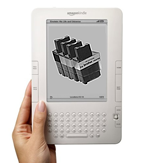Monday, June 28, 2010
Ink is to Printer Profit, as eBooks are to ....
Is the time of the stand-alone eBook reader almost past?
Will success and sales figures for Apple's iPad mark the slow and painful extinction of the Kindle, the Nook, Sony Reader, and other single-function devices?
Certainly we're witnessing a precipitous drop in pricing structure, in an effort to compete with Apple … or in an attempt to dump existing ebook reader inventories … I'm not sure which.
Amazon slashed pricing on its Kindle device by almost 30 percent last week, following a similar cut by Barnes and Nobel on their Nook. The $489 price tag for the Kindle DX puts it within striking distance of the entry level point for Apple's iPad. Comparing features, functions and diversity of user experience, there isn't even a contest there.
But rather than viewing the stand alone ebook reader hardware as a twilight technology, perhaps these same endangered manufacturers should take a look at the inkjet printer market, for some true inspiration.
As Epson, Hewlett-Packard, Brother, and others have found, that revenue stream isn't in the hardware, but rather with the expendables.
I'm talking ink cartridges.
We all know, or at least we've subconsciously sensed, that the steady payment stream from millions of ink customers far outpaces the profit from selling the printers themselves. Even with the current, disposable "when it breaks throw it away and buy another" manufacturing trends, now often would you guess the average home computer user replaces the ink jet printer? Once a year? Every 18 months? And how much does that same user spend on ink in the same time period?
You get the idea.
So, why don't Amazon and Sony and Barnes and Nobel and others apply the same profit model? Mark their hardware down to $29.99 or even give it away, for "nearly free" after rebate … that business model has existed for several years now with lower-end or discontinued printer models. With either industry, the money comes from the evergreen dollar stream on the expendables. Same could be for the electronic book content itself. An avid reader may only have one Kindle, but that one device generates the desire for dozens, if not hundreds, of electronic softgoods.
And if you recapture a huge share of the eBook market with this strategy, a substantial embedded market of happy device owners might just even tolerate a slight drift upward in the price of downloading and viewing a new release. Rather than companies sending the prices of their entire eBook catalog in the other direction, just to stay competitive.
The sustainable profit's in the content and associated pricing, dear readers, and not the gizmo itself.
Jim Furrer
Subscribe to:
Post Comments (Atom)


Printer owners, like me, were in the habit of replacing the printer for a time because it included ink and was cheaper than buying refills. Now the manufacturers sell the printers with half-sized starter ink packs!
ReplyDeleteI agree about the initial price point. It goes all the way back to "giving away the razor and selling just the blades."